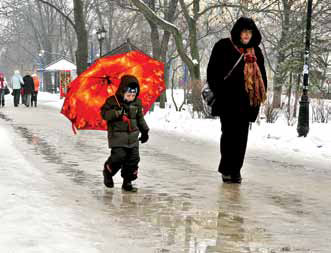 Winter tends to bring injuries from falling on the ice, so how can you protect yourself? O. Tabolich, Petrikov
Winter tends to bring injuries from falling on the ice, so how can you protect yourself? O. Tabolich, Petrikov
The number of visits to doctors grows over the winter period not just through illness but from injuries after toppling on slippery roads. However, we can follow certain safety measures to prevent the risk of injury.
Try to wear sensible footwear, with a low and stable heel and some tread in the sole. When navigating a particularly slick section of ice, walk near the edge, closer to walls or fences, so that you have something to grab if you start to lose your balance. Carry your bag over your shoulder, so that your hands are available. Meanwhile, take small steps and try to be ‘flat footed’. Take your time.
If you feel yourself falling, endeavour to roll onto your side, rather than taking the blow to your spine or the back of your head (fractures to the base of the skull can result). Also, avoid stretching your hands forward, since this can result in fractures or dislocation of wrist or forearm. Falling forward can damage your knees or ankles.
After a bad fall, assume ‘the worst’: that a fracture may have occurred. Accordingly, avoid moving limbs (on no account try to straighten a hand or foot, or set a fractured bone). Where someone has hurt their hand, they instinctively press it to their body; simply fix it in place with a scarf (or similar). If the injury is to an ankle, immobilise it with an elastic bandage, or improvised splint: rolled up magazines or newspapers, cardboard, a branch, or a piece of board. However, only do so if you can avoid causing pain.
The most serious injury would be a fracture to the base of the skull, which tends to happen when we fall backwards, hitting our head on the pavement. We may lose consciousness, and/or experience a headache, nasal bleeding or heavy breathing, or black eyes. Concussion will bring on dizziness, a cold sweat and vomiting, and the skin turns pale. Sometimes, there may be a short loss in consciousness.
In giving first aid, place the injured person on their side, to prevent closure of their windpipe and examine the place of injury. If there is no open injury to the skull, apply a cold compress, to deter swelling and alleviate pain. If foreign bodies have entered the wound, never try to touch them, since this can result in further injury or infection. Call an ambulance; medical staff will ensure the transport of the injured person to hospital in a prone position, securing the head and spine to avoid movement.
If managing an injury yourself, apply a cold compress (such as a bag of frozen vegetables) as quickly as possible, to reduce bleeding and the size of the bruise. Secure the injured limb with a tight bandage, placing your ice pack on top and keep in an elevated position. To ensure circulation, loosen the bandage from time to time. You may also apply cold lotions or simple tap water (cooled in the refrigerator).
After 24-36 hours, cold is no longer needed and the injured place should now be kept warm, to reduce bruising. Take baths, apply a heated pack and use massage. Apply anti-inflammatory preparations and, if the injury is aching strongly, you may ask your doctor to prescribe painkillers.
Needless to say, in the case of any trauma, even seemingly insignificant, do visit your doctor, since you may have a capillary fracture, torn ligament or tendon, or internal bleeding. Better safe than sorry.
By Tatiana Zhukova, doctor of higher category, D.M. Ph.D.











